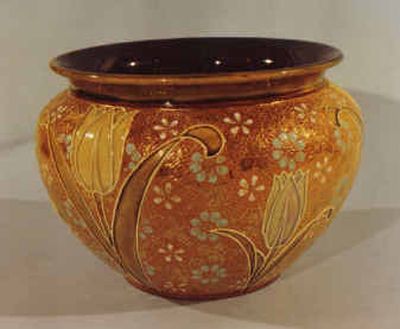Doulton bowl could fetch owner up to $150

Dear Collector: Enclosed are pictures of a Doulton & Slater bowl that belonged to my mother-in-law. Can you tell me its age and what it is worth?
Resembling a jardiniere, this short bowl with royal blue interior bears stylized tulips on its exterior.
Surprisingly, there is no date code mark, but most of these fancifully decorated pieces were made just before the end of the 19th century. I noticed the decorator’s monogram: the cursive letters “JH,” which were the initials of Joan Honey. Your letter mentions that this vase is in perfect shape; that being the case, then its value should be at least $100, but not more than $150.
Dear Collector: I recently inherited this folding fork and spoon from a relative. Could this be from the Civil War? Why does it read “Army Knife Union” when there’s no knife?
Combination eating utensils like yours were used by both sides during that conflict. The original of this jack knife configured fork and spoon was made by Union Knife Co. of Naugatuck, CT. Since replicas of this particular gadget (selling for around $20) are being produced for Civil War re-enactors, I don’t feel comfortable saying you have the “Real McCoy.”
Dear Collector: Enclosed is a photo of a Chase National Bank of New York $10 bill; is it of any value?
The first of the small series National Bank Notes, your 1929 bill has an average buying price of $13.
Dear Collector: I would like some information about a sandwich-size plate. From what I can make out, impressed on the back is “862, eenwood China, Trenton, N.J.”
The missing parts of the puzzle are “1862, Greenwood,” which is the mark used by this pottery around 1910. So now we know who made your plate and when. Hope that helps.
Dear Collector: We were given a huge collection of glass dinnerware, but have no idea who made them or how much they’re worth. Hiring an expert to do the research is out of the question; too costly. Please suggest some books to help us.
Start off with “Pocket Guide to Depression Glass & More: 1920s-1960s” (Collector Books, 2006, $12.95) by Gene & Cathy Florence; it’s inexpensive and easy to use.
Dear Collector: This coin was dug up from the ground; could you please give me some information on it?
What appears to be a small two-gram silver coin with eagle in flight on the obverse is nothing more than a modern medallion that has been removed from a money clip or key chain.
Dear Collector: For years and years, I’ve been trying to locate the history of the watch shown in the enclosed photos. Help, please!
I’m not sure of the exact date; either late 1940s or early ‘50s, but your English-made Ingersoll character pocket watch is rather unique. With a flying saucer and helmeted spaceman on its face, there’s no doubt why this beauty is called “From Outer Space.”
I found a value of $100 to $400 listed in one price guide. The lower price is for an average timepiece, while the top figure is for one in near mint, working condition.
Recommended reading: “Heisey Glass: 1896-1957,” Neila & Tom Bredehoft (Collector Books, 2001, $24.95). “The Pennsylvania-German Decorated Chest,” Monroe H. Fabian (Schiffer, 2004, $49.95). “Secrets to Affordable Antiques,” Frank Farmer Loomis IV (Krause, 2004, $17.99).